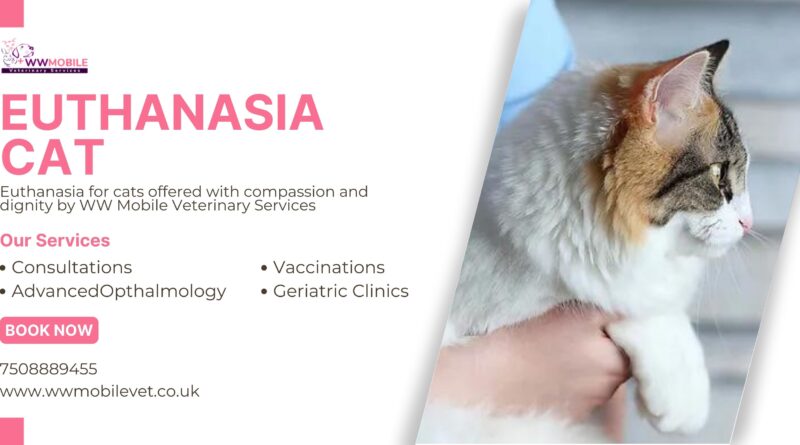Saying Goodbye with Love: A Guide to Peaceful Euthanasia Cat
The bond between humans and their feline friends is one of deep affection and mutual understanding. As pet owners, we dedicate ourselves to ensuring our cats’ well-being, offering them comfort, love, and care throughout their lives. However, there comes a time when we may face one of the most heart-wrenching decisions: euthanasia. Ensuring a peaceful and compassionate end for your beloved cat is a final act of love. This guide aims to provide support and information on how to navigate this difficult process with grace and empathy.
Understanding Euthanasia for Cats
Euthanasia, derived from the Greek word meaning “good death,” is the act of humanely ending the life of an animal to alleviate suffering. This decision often comes into play when a cat is experiencing severe illness, chronic pain, or a significant decline in quality of life. While the thought of euthanasia cat can be overwhelming, understanding the process and its implications can help pet owners make informed and compassionate choices.
Recognizing When It’s Time
Determining the right time for euthanasia involves careful observation and consideration of your cat’s health and happiness. Some key indicators include:
- Chronic Pain: If your cat is in constant pain that cannot be managed with medication, euthanasia may be a merciful option.
- Severe Illness: Terminal conditions such as advanced cancer, kidney failure, or debilitating neurological disorders often warrant this decision.
- Loss of Appetite: A significant and sustained loss of appetite can indicate a serious underlying issue that impacts your cat’s quality of life.
- Incontinence: Frequent accidents and inability to control bodily functions can cause distress and discomfort for your pet.
- Behavioral Changes: Drastic changes in behavior, such as aggression or withdrawal, may signal severe discomfort or mental decline.
Consulting with a veterinarian is crucial in assessing your cat’s condition and discussing the potential benefits of euthanasia. They can provide a professional perspective and help you weigh the options based on your pet’s specific situation.
The Euthanasia Process
Understanding what to expect during the euthanasia process can alleviate some of the anxiety associated with it. Here’s a step-by-step overview:
- Pre-Euthanasia Consultation: Before the procedure, your veterinarian will discuss your cat’s condition and explain the euthanasia process. This is the time to ask questions and express any concerns.
- Sedation: To ensure your cat is comfortable and stress-free, a sedative is usually administered. This helps to calm your pet and minimize any discomfort.
- Euthanasia Injection: A second injection, typically an overdose of an anesthetic, is then given. This causes the heart to stop peacefully, allowing your cat to pass away painlessly.
- Post-Euthanasia Care: After your cat has passed, you can spend some private time with them to say your final goodbyes. Your veterinarian will discuss options for aftercare, including cremation or burial.
Choosing the Right Setting
Where euthanasia takes place can significantly impact both your and your cat’s experience. Many pet owners opt for at-home euthanasia to provide a familiar and comforting environment for their cat. Mobile veterinary services, such as those offered by www.wwmobilevet.co.uk, specialize in home visits, ensuring a peaceful and personalized experience.
Benefits of At-Home Euthanasia:
- Comfort: Your cat can remain in a familiar and stress-free environment, surrounded by loved ones.
- Privacy: The intimate setting allows for a more personal and private farewell.
- Convenience: It eliminates the need for transportation, which can be stressful for both you and your cat.
Coping with Grief
The loss of a pet can be devastating, and it’s important to allow yourself to grieve. Each person’s grief journey is unique, and there is no “right” way to mourn. Here are some tips to help you cope:
- Acknowledge Your Feelings: Allow yourself to feel the full range of emotions, whether it’s sadness, anger, or guilt. Suppressing your feelings can prolong the grieving process.
- Seek Support: Talk to friends or family members who understand the bond you shared with your cat. Support groups and pet loss hotlines can also provide comfort.
- Memorialize Your Pet: Creating a tribute, such as a photo album, memorial garden, or custom keepsake, can help honor your cat’s memory.
- Professional Help: If your grief feels overwhelming, consider seeking support from a counselor or therapist specializing in pet loss.
Preparing for the Future
After the loss of a pet, some people may feel they can never have another pet, while others may find solace in adopting a new companion. There is no right or wrong decision—only what feels right for you. Taking the time to heal and reflect on your readiness for a new pet is important.
Conclusion
Deciding to euthanize a beloved cat is a profound act of love and compassion. By prioritizing your pet’s comfort and well-being, you provide them with a peaceful and dignified end. Remember that you are not alone in this journey—veterinarians, support networks, and compassionate services like www.wwmobilevet.co.uk are here to help you navigate this difficult time.


